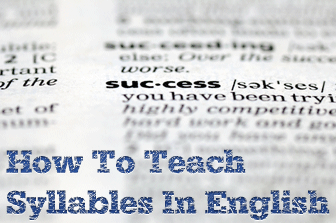Getting Started, Getting Understood: Issues for Beginning ESL Pronunciation


Why not try some of these catchy syllable activities with your ESL class the next time you plan to talk about rhythm in spoken English.
What is a syllable?
Helping ESL students understand the concept of syllables can be challenging, but it is necessary for good pronunciation skills. As part of a pronunciation lesson, have available for your students several small, hand held mirrors. Using a list of vocabulary from your current unit, have students repeat one word at a time after you, concentrating on clear pronunciation. Encourage your students to watch your mouth as you say each word. Then as they repeat the word, have them watch their own mouth in the mirror. Point out that with each vowel sound (not necessarily each vowel in the word) your mouth opens. Each time your mouth opens, you pronounce one syllable. Have your students count the number of syllables in each of their vocabulary words as they watch themselves in the mirror. While working in pairs, have your students group those same vocabulary words by the number of syllables each contains creating a list for one-syllable words, another list for two syllable words and so on.
What is in a name?
Another way to help your students understand the number of syllables in a word is to tell them that the number of beats in a spoken word corresponds with the number of syllables in that same word. The number of letters in a word or the way that word is spelled are not indicative of their syllabic structure, but simply clapping along with speech can make clear how many syllables that word contains. To practice counting the number of syllables in words, have your class take turns saying their names aloud. As each person says his name or as you say it, have your class clap along with it and count the number of claps. Once you have practiced the number of syllables in all the names of your students, give each person a list of his classmates and have him write down how many syllables each name contains. Do boy’s names or girl’s names usually have more syllables? Which nationality’s names has the most syllables?
Open and Closed
During your lesson on syllables, it may be a good time to show your students the difference between a closed syllable and an open syllable. A closed syllable is one that ends with a consonant sound. Most often, the vowel sounds in closed syllables are short vowel sounds. You may want to select some examples from their current vocabulary lists or write other examples on the board such as helmet or candid. Open syllables are those that end with vowel sounds. Most often, these vowels are long vowel sounds. Again, use examples from your current vocabulary list or supply other words like sky or raven. Once students understand the difference between an open and closed syllable, point out that this knowledge can help them pronounce new words. By breaking the word into syllables and then determining whether those syllables are open or closed, your students can make educated guesses about vowel pronunciation when they encounter unfamiliar vocabulary.
The Root of It All
A natural extension of breaking words into syllables may be reviewing word roots, prefixes and suffixes. Your students will benefit from knowing that meaning can be found in the building blocks of words and that these building blocks can often be found in syllabic breakdowns. Take some time to review commonly encountered word roots including mal (bad), bene (good), ology (the study of), un (not), vis (see), and any other word roots that may make up your class’ current vocabulary words. If you are unsure which word roots may be a part of the vocabulary you are using in class, you can check this online source for word roots. Encourage your students that the more word roots they memorize and know, the easier it is to break down new vocabulary into pieces and decipher their meanings.
Take the time to review syllables today and your students will surely benefit now and well into the future.